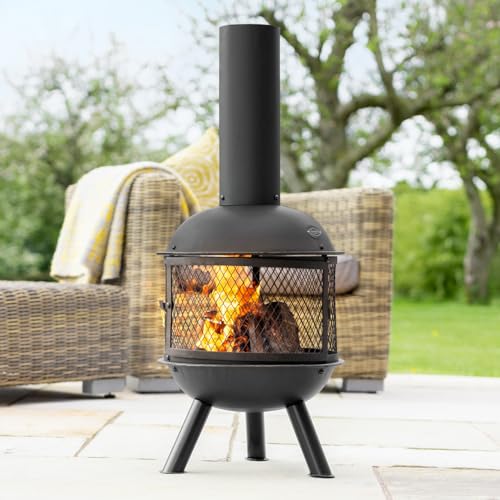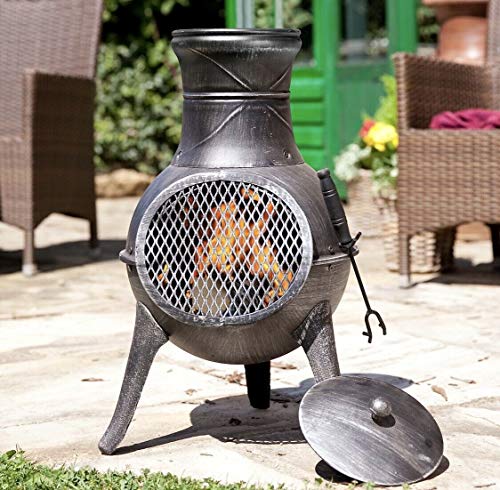Are You Sick Of Ceramic Chiminea? 10 Inspirational Resources To Revive…
페이지 정보
작성자 Shelia Griswold 작성일24-11-22 01:08 조회6회 댓글0건관련링크
본문
 Ceramic Chimineas
Ceramic Chimineas Ceramic chimineas offer a traditional, rustic look that can add warmth to any outdoor space. They are also simple to maintain. They are available in a wide range of styles. They can also be glazed to enhance their appearance.
Ceramic chimineas offer a traditional, rustic look that can add warmth to any outdoor space. They are also simple to maintain. They are available in a wide range of styles. They can also be glazed to enhance their appearance.Like all chimineas, they must be kept away from structures with overhanging and any other structure that could catch on the fire. They also are susceptible to damage caused by precipitation, frost and sudden temperature fluctuations.
They are made from clay or terracotta
A chimenea can be an ideal addition to your patio or backyard. It will provide warmth and ambiance to any garden event. They are simple to use, providing an inviting fire with an impressive chimney that disperses the smoke throughout the air. They are available in various sizes and shapes, as well as decorative finishes and designs. Chimineas made of clay can be costly but the style and durability of this product make them worth the cost.
Certain chimineas can be used to cook food while others are specifically designed to heat. The chimney is designed to direct the smoke into the air to protect the fire from wind or rain and allows you to manage the heat better. Some chimneys come with a grill that lets you cook your favorite foods on the grill.
Cast iron chimineas tend to be more durable than clay ones and can last generations if they are maintained properly. However, the price is higher and they can be a bit more difficult to move around. They are typically painted with a heat-resistant paint to stop rust from occurring. Moreover, they tend to heat up on the outside, so care should be taken when children are present. They are also more likely to break if exposed to abrupt temperature fluctuations or physical damage.
The potter smoothes the outer and interior surfaces of the clay chiminea prior to it dries. The clay is then fired at high temperatures in a kiln before being glaze it if needed. The resulting chiminea is prone to changes in temperature and moisture so it is advised to find a suitable spot for it in the garden and cover it with a chimenea covering when not being used.
Before they can be lit, clay chimineas require to be cured.' This is done by putting a layer or river sand on the bottom of the chiminea and adding small pieces of wood to create a small flame. After the fire has burned out, the sand is removed and the chiminea may be lit.
They are available in a variety of styles
Chimineas add a rustic or Southwestern charm to any outdoor area for entertaining. They are highly efficient heaters and provide a focal point for gathering with friends. They are also a great way to create a dramatic display for your garden. The fireplaces that burn wood are typically built in a bell shape with a chimney which directs the heat and smoke up into the air. The chimney is used to shield the fire from rain and wind. Once the fire is lit, chimineas can complete their burn in around 15 minutes and give off a lot of heat. You can make use of different kinds of wood to fuel your fire pits & chimineas, including aromatic cedar and the hickory.
Cast iron and copper chimineas have been gaining in popularity. These newer chimineas can handle higher temperatures than traditional clay ones which makes them more flexible and durable. They can also be used to grill and barbecue as well as burning wood. Many of the more modern models have an adjustable grate that makes it easier to control flames. They also come with a heavy-duty cover that protects the chiminea from damage and a spigot for putting in water.
Some modern clay chimineas are additionally grogged to help them resist thermal stresses that can fracture traditional earthenware objects. However, they're fragile and should be placed in a tiled, concrete or stone base to avoid them from falling over. They can be used with charcoal, wood, and other sources of fire, however they are most effective with hardwoods like oak, hickory and acai.
When choosing the plants to be placed in the chiminea's surrounding, remember that they should be able to handle heat. They shouldn't touch the chiminea. The plants should be laid out in such a way that they create a backdrop, or screen, for your chiminea. Evergreens such as boxwood and holly will increase the height of your arrangement. Flowers like lavender or roses will add hue.
The chiminea chimney vents smoke away, making it more secure to use than a firepit, which is an open fire pit that requires frequent refueling. Keep any flammable substances away from your Chiminea Extra large. Avoid direct contact with water with the chiminea after it's been heated. This can cause it to crack.
They are easy to maintain.
The kind of chiminea you select will depend on the style you wish to achieve, the types that are available and the purpose you want to use it for. Clay is biodegradable and good for the environment, whereas metal varieties can last longer, but require more maintenance (such as coatings to stop rust).
It is crucial that the chiminea's ceramic has completely cooled before cleaning it. Make sure it's located in a spot in which ash and sparks don't fall onto anything which could ignite. If you are unsure how to do it, ask an expert or your local fire department for safety guidance.
To clean a Chiminea surface, dust it thoroughly to get rid of dirt and other debris. After that, you can start to take on the tougher stains with a sponge or brush. Make use of a non-flammable substance such as mild detergent or bleach. After cleaning, rinse the chiminea well with fresh water. Allow it to dry completely before using it again.
Once the chiminea is cleaned and dried it's a good idea to add a layer of sand in the base to keep the clay cool and stable. This will make it last longer and reduce the possibility of cracking. Sand can be any kind but the lava rocks are particularly effective. The lava stones also add an additional layer of insulation and keep the chiminea cool. This makes it safer to use.
The best way to prevent corrosion is to regularly sand the chiminea's surface. However, you should be cautious not to soak it with water, because this could lead to cracking. The chiminea can be painted using an anti-rust paint to guard against future corrosion.
When a chiminea is not being used it should be covered with a waterproof cover for a chiminea. This will help it withstand snow and rain, and will make the extra large chiminea appear more attractive. The cover will also protect it from rust and other damage caused by direct sunlight. You can purchase a chiminea lid at the local home improvement store or online.
They are safe
Chimineas are extremely safe when used correctly. Like all fire apparatuses they can be dangerous if not maintained. Chimineas can be made from clay or metal, and should only be used outdoors. They shouldn't be used in a flammable building like your home. It is important to keep a watchful eye on the chiminea when it is in use and to not allow it to get too hot. This will prevent the chiminea from cracking or being damaged. If you notice cracks in the chiminea's chiminea's surface, use ceramic caulk, such as RTV silicone high temperature caulk. It is designed to stand up to high temperatures, so it is ideal for this kind of application.
Chimines are also susceptible to damage by wind, rain and snow. To protect it from weather damage it is recommended to store it under a cover over the winter. If you are unsure how to store your chimenea seek advice from the manufacturer. Chimeneas can be kept either in a shed or garage however, you can also purchase a protective cover.
In contrast to regular fireplaces, chimineas aren't sealed and therefore offer less control over the flames. They can also release a lot of hot sparks since they don't have a secure seal. If this is a problem then you can install chicken wire or a small holed fence around the outside of your stack to smother the sparks. You can make your chiminea more safe by using seasoned wood because it will create less sparks than unseasoned.
While a chiminea is more user-friendly than an open fire, it's an extremely hot stove and should be kept away from flammable objects like trees or porch roofs. Keep pets and children away as it can emit sparks or embers which could ignite them. Chimineas should be placed on the patio hearth. This is an area that is covered with pavers or other fire-safe materials, to create a safe zone. Chimineas must also be placed away from eaves and other overhead objects which could catch fire.
댓글목록
등록된 댓글이 없습니다.














